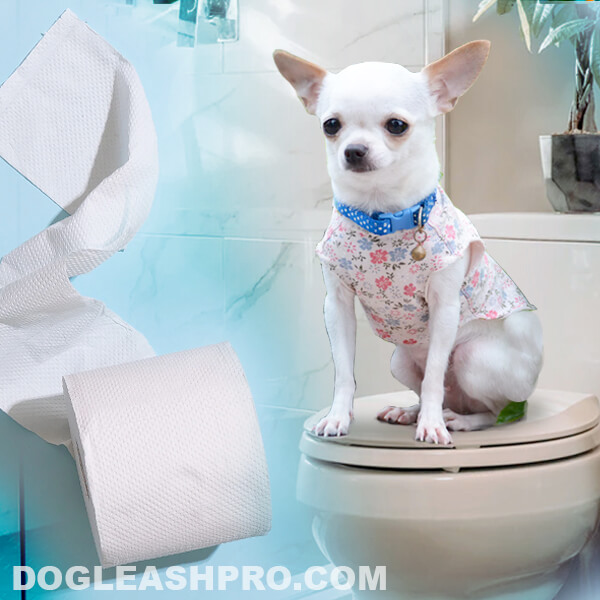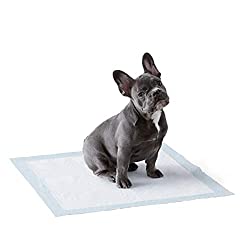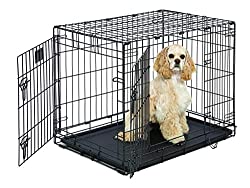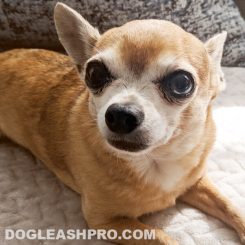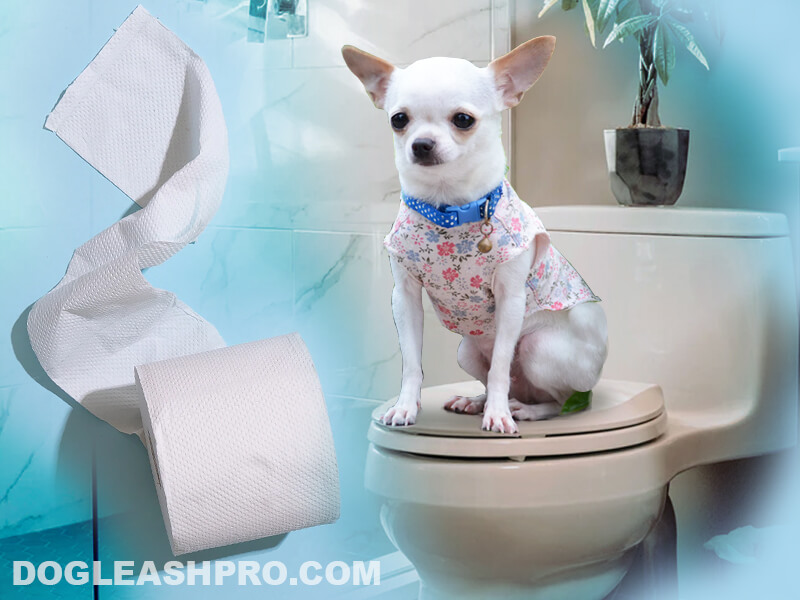
You’re probably reading this article because you’re expecting a Chihuahua soon or you’re a first-time Chihuahua owner. Let me tell you that you will be amazing and you both will have a wonderful experience together. However, having a Chihuahua does come with many challenges, and the training can get difficult.
One of many training includes potty training a Chihuahua. In this article, we’ll discuss everything you need to know about potty training a Chihuahua-from the best age to potty train to when and where it’s ok to go potty.
To make it easier for first-time Chihuahua owners, we’ve provided 10 steps to properly potty train your Chihuahua. Along with training, you’ll also want to make sure your Chihuahua has good oral health. All of this requires time and patience from the owners.
Table of Contents
Chihuahua Potty Training: What you need
By the time your baby Chihuahuas reach 3 to 4 months of age, you can start to potty train them. Young Chihuahuas can be stubborn so around this time, it’s best to start the potty training process.
To successfully potty train a Chihuahua, a Chihuahua owner will need the following:
- Chihuahua puppy pads.
- Dog crate for Chihuahuas (you could get a crate pad to make it more comfortable).
- Convertible pet gate.
- Toilet paper or wipes.
How to potty train a Chihuahua: 10 Easy Steps
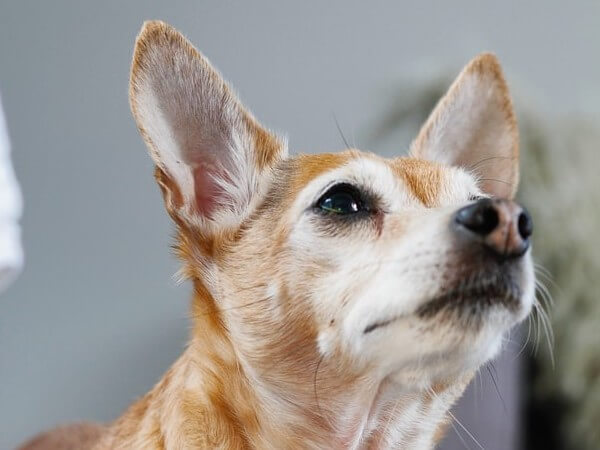
If you’re a first-time dog owner or you are new to potty training a Chihuahua, don’t worry. Ten years ago, I was also in the same position. As a first-time Chihuahua dog owner, I didn’t know where to start so I understand how stressful it can be.
In our Chihuahua potty train guide, we’ll go over 10 easy ways to potty train your young Chihuahuas. Let’s start!
1. Chihuahua potty training routine is key!
After you have purchased the necessary house training materials, it’s time to establish a potty training routine. Successfully potty training will provide the necessary skills your Chihuahua needs throughout its life. A baby Chihuahua’s bowel and bladder are determined by how much they drink and eat as well as their sleeping cycle or circadian rhythm.
When you start potty training your Chihuahua, here’s what you can do:
- As soon as your little Chihuahua wakes up, you should immediately take her out to do her business. This should be done first thing in the morning.
- If your baby Chihuahua wakes up from a nap, take her out to do her business as soon as possible.
- At night right before your young Chihuahua heads to sleep, take her out again. This will help to avoid any accidents overnight. (If you’re going to be gone for more than a few hours, it’s best to take your baby Chihuahua out to pee or poop before you leave. This will prevent any accidents while you’re not there).
Baby Chihuahuas usually have a weak bladder so if this is your first-time potty training your Chihuahua, it’s best to take them out to pee every 30 minutes. Once your young Chihuahua is used to this routine and she grows a bit older, you can take her out to pee every 1 hour.
Since Chihuahua owners will need to create a routine around their Chihuahua’s bathroom routine, we highly recommend that you begin a diary to keep track of the time you feed your baby Chihuahua and what your pup ate. This will help you predict when your young Chihuahua needs to go poop or pee.
When we first got our baby Chihuahua, Lily, this diary helped us keep track so we could adapt to her habits.
Fun Fact: Speaking of dog poop (I know, gross right!), you’ll be surprised to find out how long it takes for dog poop to decompose.
2. Well-balanced diet with portion control
When it comes to your newborn Chihuahua’s diet, make sure to keep a diary as mentioned above. This will start the routine of when your Chihuahua is eating and when she should go out and do her business, whether it is peeing or pooping.
Since young Chihuahuas have a weak digestive system, the food that they eat will naturally trigger their digestive system more quickly. This means that a baby Chihuahua will need to go pee 15 minutes after eating and will need to poop about 30 minutes after eating.
Being that a young Chihuahua’s digestive system is not matured yet, it can not take in so much food at one time, we highly recommend that Chihuahua owners feed their small four-legged friends 3 times a day with 3 tiny meals. As the Chihuahua grows older, then you can switch to 2 larger meals a day.
Right after each meal, we advise that you take the food bowl away. This prevents the Chihuahua owners from adding any more food into the food bowl and the little Chihuahua can avoid overeating.
Since your baby Chihuahuas can only eat 3 times a day, it’s best that you make those 3 meals count. Every meal should include food that is both high-quality and well-balanced. If you’re feeding your young Chihuahua Chicken meat, make sure it is easy to chew and in small pieces. While a Chihuahua’s teeth are pretty strong, you don’t want to provide food that is difficult for them to chew.
We highly recommend that Chihuahua owners also avoid feeding their young Chihuahuas food that contains preservatives, sugar, salt, artificial colors, and any ingredient that is toxic to dogs such as onion and garlic.
Fun Fact: While a Chihuahua’s teeth may look small, you’ll be surprised by their bite force PSI!
3. Provide a confined space for your Chihuahua
In the early stages of Chihuahua potty training, it’s best to provide a confined space for your Chihuahua. A confined space could be a crate or a small area of a living room or bedroom until you feel comfortable and confident that your young Chihuahua can wander around the house without any accident.
Your baby Chihuahua may cry because she feels alone in the confined space. If this is the case, make sure your Chihuahua doesn’t stay in the confined space for way too long. Provide love and affection to your Chihuahua and allow her some time to explore other areas of the house, but be sure to keep an eye on her.
4. Consistency, consistency, consistency!
When it comes to Chihuahua potty training or other types of training, consistency is key. Consistency also helps a young Chihuahua learn. In addition to providing your baby Chihuahua with a confined space, you’ll want to introduce your Chihuahuas to a specific area of the house that they can pee in if you’re not at home.
Alternatively, if you have an electronic dog door, you can introduce your Chihuahuas to a specific area outside in your backyard so that they can do their business when you are gone for an extended period of time.
Consistently teaching them to go to that area of the house or in your backyard to go potty will help them associate that area of the house or backyard as the area that they can pee or poop when you are not home.
The best way to transition your Chihuahua into toilet training is by crate training or pad training a Chihuahua.
5. Training a Chihuahua to use a pee pad
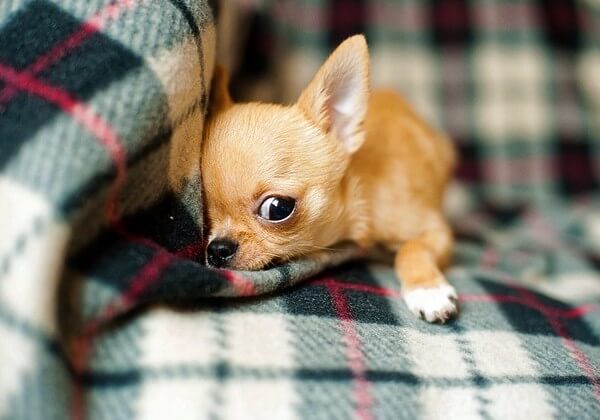
Pad training a Chihuahua is a great way to introduce your small pooch to a specific area of the house where they can do their business if you are not home. This is used for a short-term solution while they are in training.
This is the pee pad we used for our Chihuahua, Lily:
Of course, we want our Chihuahuas to eventually do their business when they are out on their daily walks. But sometimes, Chihuahua owners do get busy or have a busy schedule and a Chihuahua can’t hold in any longer. This is when the pad comes in handy.
When we started pad training our Chihuahua, Lily, we placed non-slip pads or towels underneath the pee pad so the pee pad doesn’t move around when she steps on it to pee.
Training a Chihuahua to use a pee pad is wonderful because it solves two problems:
- Reduce the mess! Who wants to clean up pee on the floor at the end of a long day at work? The pee could be sitting on the floor for hours when you’re at work and the acidity in their pee could ruin your flooring.
- Allow your baby Chihuahua to know that there is a specific area in the house that they can do their business and nowhere else. This means it’s easier for the Chihuahua owners to clean up as well.
Once your young Chihuahua associates the pee pad with an area that they can do their business while you are gone, then you can immediately begin to move the pee pad outside in your backyard or patio to help them learn that it is best to pee and poop outside and not inside the house.
6. Crate training a Chihuahua
We mentioned crate training a Chihuahua above, and we’ll go in-depth about it here.
When you’re starting to potty train your Chihuahua, using a crate is a perfect way. A crate provides a confined area for potty training. When a Chihuahua is in a crate, she will want to make sure the crate is clean as this is her resting and sleeping place.
She’ll want to avoid peeing or pooping in there because she knows she’ll have to stay in the confined space for a while. This teaches the Chihuahua to avoid making any mess in there and to hold it until their owners let them outside to go potty.
When finding a crate for your Chihuahua, you’ll want to go with one that is large enough for your young Chihuahua to stand, turn around, and lie down. Don’t get a crate that is way too big for your Chihuahua because this will encourage your small pooch to pee and poop in there and that’s not what we want.
7. Chihuahua owners need to learn the signs that a Chihuahua needs to go potty
While a young Chihuahua is potty training, a Chihuahua owner needs to also learn how to recognize signs that their Chihuahua needs to go pee or poop.
Some signs that a Chihuahua needs to go potty are:
- Heading to the specific area they have peed or pooped in.
- Staying in the specific area they did their business in.
- Looking very anxious.
- Circling around the owner or around the room.
- Very restless and walking around the house more than usual.
- Sniffing the floor.
If you notice any of these common signs in your young Chihuahua, it’s best to take her outside immediately and go to the specific spot you want her to do her business.
While a young Chihuahua is still growing and learning her potty training, expect some accidents to happen. When accidents do happen, don’t yell or get angry. Instead, staying calm is the key in this situation. Avoid getting upset or angry as this could scare your little Chihuahua and make them more anxious and stressed.
An anxious and stressed Chihuahua is more likely to cause accidents and this is what we want to avoid.
Fun Fact: When Chihuahuas are still growing, it’s common for Chihuahuas to have floppy ears. While Chihuahuas are growing and developing, they are curious about the world around them and will learn and explore the world around them so having patience is key.
8. Chihuahua potty training: Use a specific phrase
While potty training your Chihuahua, we highly recommend that owners use a phrase that their Chihuahua can learn to identify with going potty.
For example, when we were potty training our little Chihuahua, we used the phrase, “go potty or go pee-pee.” Every time we took her outside to the backyard, around the block, or to his pee pad inside the house, we would immediately say “go potty.”
This was very effective and it worked! Our young Chihuahua learned to identify “go potty” and the location while doing her business and that’s exactly what we wanted.
After about 3 months, our Chihuahua immediately knew what to do when I said “go potty” or “go pee-pee.”
9. Reward your baby Chihuahua accordingly
After your young Chihuahua finished pooping or peeing in the right location, rewarding her with either dog treats or praise is important. These proper associations with positive reinforcements will keep her on the right track.
Soon enough, your Chihuahua will have good potty behavior and you will start to see success.
10. Always remember to avoid yelling or scolding your Chihuahua
While potty training your Chihuahua, always keep in mind to stay patient and calm. It’s never helpful to yell at your Chihuahua while training them. Our baby Chihuahua is still learning and will not be perfect the first time around. Accidents will happen and Chihuahua owners should expect it.
In the best-case scenario (and mostly rare), your baby Chihuahua didn’t have any accidents.
When accidents happen, stay calm while cleaning up the mess. Avoid shouting at your baby Chihuahua as it won’t do any good. Shouting at your little Chihuahua would only make her afraid and can lead to fear, anxiety, and stress.
These three feelings would only cause your Chihuahua to pee more accidentally when they don’t mean to as they are nervous.
I totally understand how frustrating it is when my cutie Chihuahua would have accidents on the living room floor. We would clean up after her for her to pee again not even a minute after. This happened many times during potty training.
Sometimes our Chihuahua would also poop on the carpet in the living room if I’m away at work for more than 8 hours. It happens and it is totally understandable.
Chihuahua Potty Training: when to start?
When your baby Chihuahua turns 12 weeks old, you can start potty training her. The time frame to start is between 12 weeks to 16 weeks of age.
This is the perfect time to potty train a Chihuahua because, at this point, they are able to control their bowels and bladder. They have the ability to hold it when they have to.
During this time, the young Chihuahua can start to learn good potty behavior and it is easy to train Chihuahuas when they are young. Their behavior is easily molded so it’s easier for Chihuahua owners to potty train at this time.
How do you potty train a Chihuahua fast?
Potty training a Chihuahua should be at a consistent speed. Don’t try to rush the Chihuahua potty training process. Rushing the Chihuahua potty training process can make you feel agitated and impatient and accidentally yell at your baby Chihuahua for any accidents.
Instead of trying to speed up the potty training process, consistency is key. It also depends on your Chihuahua’s learning curve and every Chihuahua is different. There are also environmental factors as well as your Chihuahua’s personality and temperament that affect how long it takes to potty train a Chihuahua.
When we were potty training our Chihuahua, it took between 4 to 6 months. It wasn’t easy and was frustrating at times, but we kept our cool and continued with the potty training. We try to keep distraction at a minimum during potty training.
Some Chihuahuas can take just a few months to be properly potty trained while other Chihuahuas could take up to 1 year.
It also depends on how old your Chihuahua is when you bring her home. If you bring a baby Chihuahua home when she is more than 12 weeks of age, she may need to unlearn some bad potty behaviors from her previous owners.
No matter how old your Chihuahua is or how long it takes your Chihuahua to learn proper potty behavior, always expect accidents to happen. And when accidents happen, have some wipes or toilet paper handy to clean up the mess. Have backups ready as you can expect to use a lot of this.
Lasting thoughts
We hope these 10 steps help you potty train your Chihuahua and we’d love to hear how your potty training went. Potty training a Chihuahua isn’t an easy task but the end result is very rewarding, not only to the Chihuahua owner but to the Chihuahua as well.
Consistency and patience are key and it’s best not to rush through the potty training process. With patience and the right attitude, your baby Chihuahua will learn a skill they will need throughout their life. Potty training your Chihuahua is just the beginning as there are other training your Chihuahua will need to go through.
If you’re concerned or still need help with potty training a Chihuahua, we highly recommend that you consult with your vet or a professional Chihuahua trainer. They will guide you along and should be able to show you in person.
DISCLAIMER: THIS WEBSITE DOES NOT PROVIDE MEDICAL ADVICE
The information, including but not limited to, text, graphics, images and other material contained on this website are for informational purposes only. No material on this site is intended to be a substitute for professional veterinary advice, diagnosis, or treatment. Always seek the advice of your veterinarian or other qualified health care provider with any questions you may have regarding a medical condition.
Resources:
https://en.wikipedia.org/wiki/Chihuahua_(dog)

With over five years of specialized experience as an animal writer, my expertise lies in dog nutrition, health, behavior, grooming, and training. I am dedicated to delivering helpful and informative content that caters to the well-being of our furry friends. My primary goal is to empower pet owners with knowledge and ensure our canine companions thrive in health and happiness. In my free time, I love volunteering at local dog rescue centers.
